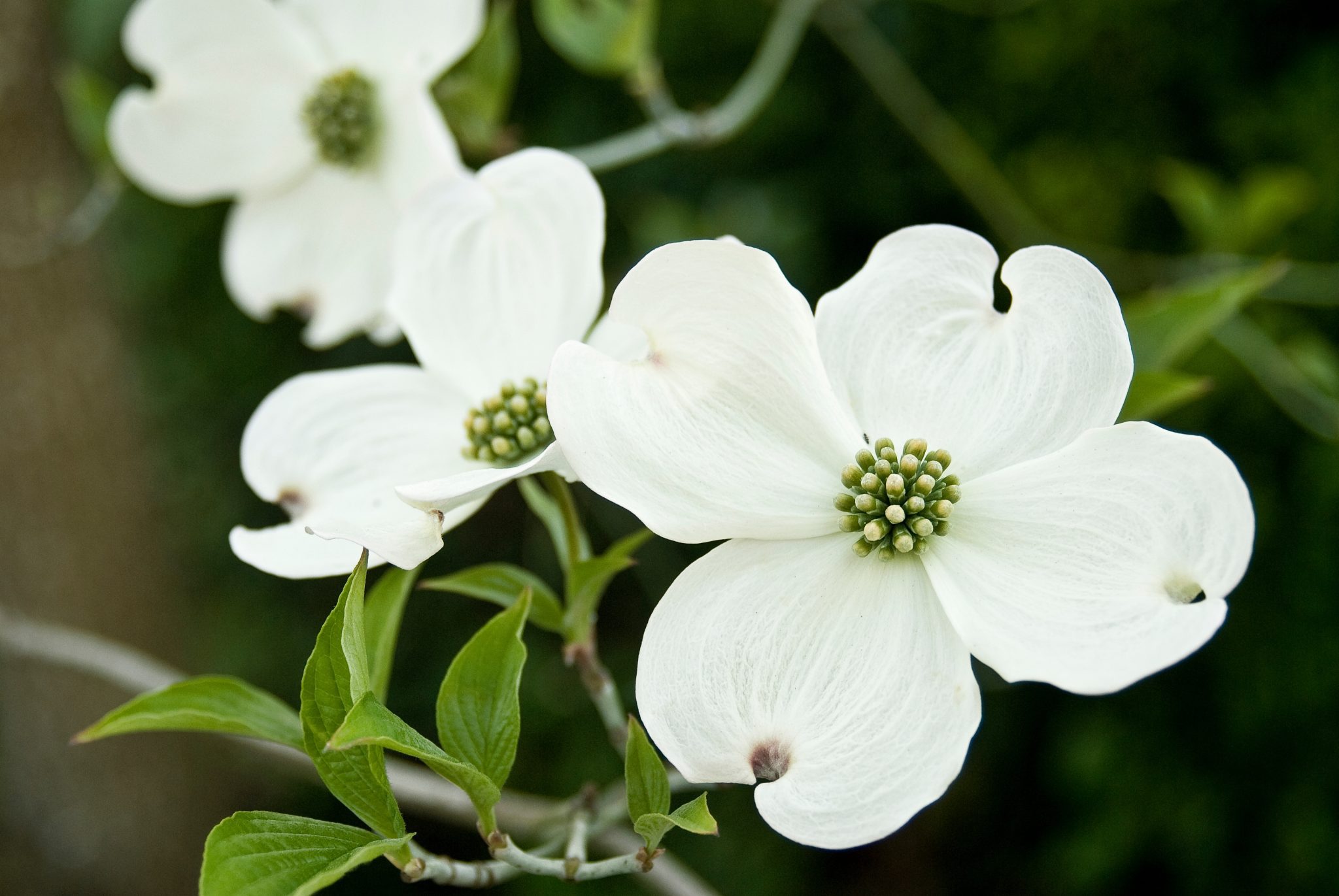Landscaping

The most popular spring flowering tree in Alabama is the flowering dogwood. With proper care, the dogwood adds natural beauty to the landscape year-round. Learn recommendations for site selection along with transplanting, watering, fertilizing, mulching, and controlling insects and diseases.
The flowering dogwood (Cornus florida) is native to the eastern half of the United States. It is a deciduous tree that can grow 15 to 30 feet in height and is generally wider than it is tall. The dogwood is cold hardy to 15 degrees F, so it is well adapted to the entire state of Alabama.
You will learn the general care and maintenance of dogwoods. In addition, you will gain illustrated instructions for planting and pruning and a list of the most common varieties and cultivars—their growth rate, color, susceptibility to disease, and other characteristics.
Bracts and Flowers
In the spring, the dogwood’s main attraction is its showy bracts. The bracts are commonly mistaken for the flower, but they are actually modified leaves that encircle the true flowers. The true flowers of the dogwood are small, greenish-yellow flowers that bloom shortly after the bracts open in the spring. The bracts and flowers together are commonly referred to as the flower.
The dogwood begins blooming in late March in the southern portion of Alabama and 2 to 3 weeks later in the northern areas of the state. The bloom duration can last from 2 to 4 weeks. The flower size ranges from 3 to 6 inches across.
The flower color of the native dogwood is creamy white. A naturally occurring variety of the native dogwood, Cornus florida rubra, has pink blooms. Many cultivated varieties have been produced from native dogwoods. These range in color from white to pink to red.
Foliage
Besides the grand floral display in the spring, the dogwood produces luxuriant light-green foliage. The light-green spring foliage turns to a rich green in summer, furnishing light shade in the long, hot days.
In autumn, the leaves turn red or reddish purple. The duration of fall color depends on the cultivar but can range from early September to mid-January. The dogwood’s fall color from year to year is consistent, but intensity varies with environmental conditions. Red fruit accompany fall foliage. These red drupes are 1⁄3 inch long and usually in a cluster of three to five. The fruit are devoured by many different species of birds.
To round out its year of beauty, the dogwood displays gray-black checkered bark in the winter.
Uses in the Landscape
Dogwoods are versatile in the landscape. They can be used in a grouping or alone. Dogwoods can serve as a corner planting if spaced well away from the house. A mature canopy can be 15 to 30 feet in diameter. They also may be used as a backdrop for azaleas or other spring-flowering shrubs. Since dogwoods thrive in partial shade, they can be used as an understory tree, especially under the canopy of larger pine trees. The uses of dogwood are vast, but careful consideration is important for the survival of the tree.
Site Selection
The native dogwood will grow in a wide variety of climates and soils. Make sure the chosen site is well drained but does not get extremely dry. Dogwoods also prefer soils that are high in organic matter. The optimal soil pH range is 5.2 to 6.0. If you are not sure of your soil pH, call your county Extension office for information on how to submit a soil sample for analysis.
A site should provide partial shade. Trees planted in partial shade generally perform better than those planted in full sun or deep shade. Trees planted in full sun are smaller, more densely branched, and have profuse blooms. However, a full-sun location can be a stressful site for your tree. Full-sun exposure makes the tree more susceptible to the dogwood borer, one of the main causes of death of dogwoods in the landscape. Dogwoods planted in full sun must have an adequate supply of water. Plant dogwood trees in northern or eastern exposures to protect them from late afternoon sun.
Transplanting
Buy nursery-grown trees rather than transplanting trees from the wild. Nursery-grown trees are root-pruned and grown in prepared soil, which gives the tree a denser root system that is better suited to withstand stresses of transplanting. Select cultivars also offer early blooming with longer and more prolific flowers. Nursery-grown trees can be purchased container-grown, balled and burlapped (B & B), or bare root.
Purchase only trees that are healthy and well maintained by the nursery. Avoid trees with suckers, weeds, sunken places, or scarred bark on the trunk. Also look for small holes at the base of the tree, indicating the presence of borers. Such trees are not likely to survive long even in the best site.
Proper planting techniques encourage root growth, which results in a more healthy, vigorous tree. Techniques for planting a dogwood depend on how the tree was grown and harvested.
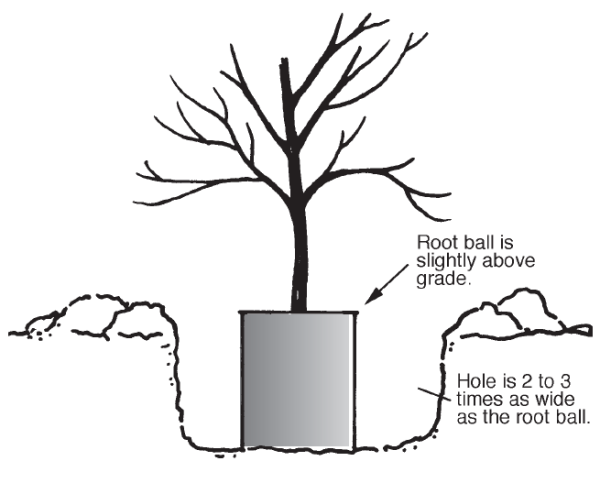
Figure 1. Proper planting of your tree
Container-Grown Trees
Planting container-grown trees can be done year-round. Optimal planting time is in the fall because it allows enough time for the roots to become well established before the summer heat.
Your tree should be planted no deeper than it was grown in the nursery. In some cases though, nursery container- grown trees are planted too deep. To ensure you are planting the root ball at the proper depth, remove the soil at the top of the root ball until you see the topmost roots. These roots should be level with the surrounding soil grade at planting. Better still, place your dogwood slightly above grade. That is, the hole can be dug slightly shallower than the height of the root ball (figure 1).
Dig the planting hole at least two to three times wider than the root ball width. This will promote more uniform and rapid root establishment in the soil surrounding the root ball. It is not necessary for you to dig any deeper than the root ball.
Gently massage the root ball with your hand to loosen roots and expose them to the native soil. This encourages better root formation and prevents roots from circling in the hole. Refill the hole with the same unamended soil that was taken from the hole. A mixture of one-third organic matter, such as peat moss or compost, to two-thirds of soil may be helpful, but in other tree species it does not appear to be necessary. Gently firm the soil around the root ball and water thoroughly.
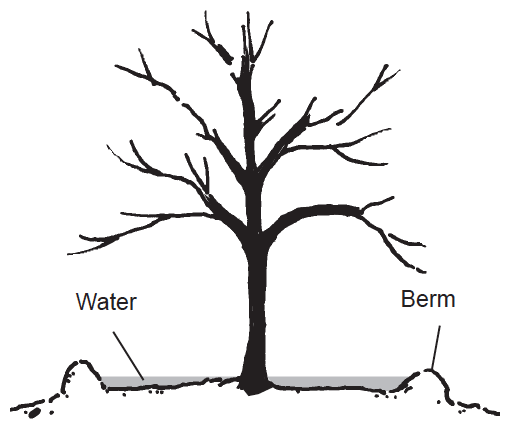
Figure 2. Build a berm around the tree, using the remaining soil.
Build a berm around the planting hole with the remaining backfill soil if the tree is on a slope or planted in sandy soil (figure 2). This directs water to the root zone within the hole. Water once more to ensure that the soil is well settled.
Balled and Burlapped Trees
Balled and burlapped (B & B) trees should be planted when they are dormant, from November to February. Planting procedures are similar to planting a container- grown tree; however, there are some unique planting practices required for B & B trees.
When you receive a B & B tree from the nursery, the topmost roots may be covered with soil. This is due to the process used to dig them up. When digging the hole for planting, as with container-grown trees, make sure that the highest root coming off the main trunk is even with or slightly above the surrounding soil line.
Cut all ties and fold back the burlap into the bottom of the hole. Be sure the burlap is covered by soil; exposed burlap can wick water away from the root ball. Handle the tree by the root ball instead of the trunk to prevent cracking of the ball and the fragile roots. Avoid dropping the root ball, which can crack the root ball and roots as well as compact the soil in the root ball.
Bare-Root Trees
Bare-root trees are generally less available in retail garden centers than container or B & B plants. Bare-root trees must be planted immediately or have moist soil or organic matter put around the roots to prevent the roots from drying out.
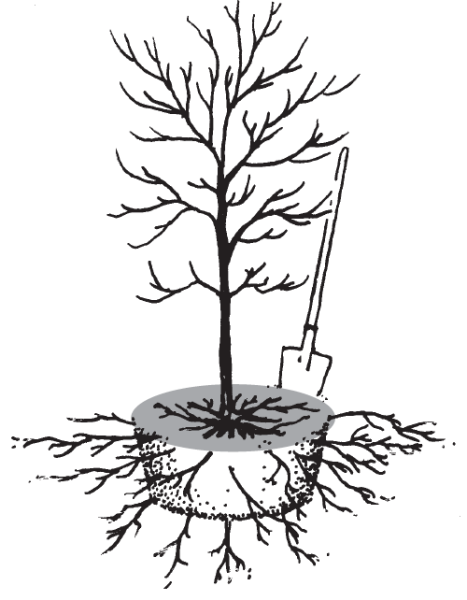
Figure 3. Root-prune the tree 1 year before moving it from a natural area.
A bare-root tree should be planted while dormant. Dig the same wide, shallow hole recommended for container or B & B plants. Prune any damaged or diseased roots before placing the tree into the hole. As with B & B or container-grown trees, plant the tree where the highest root coming off the main trunk is even with or slightly above the soil line. If needed, shovel part of the soil back into the hole so that when the tree is placed into the hole it sits slightly above the original soil line. Next, refill the hole with the remaining soil. The final step is to water the tree thoroughly.
Transplanting from the Wild
Transplanting dogwoods from the wild can be difficult, and the survival rate is usually low. If you choose to transplant from the wild, do so while the tree is dormant and small, generally 1 inch or less in diameter. Ideally, root-prune the tree 1 year before moving it.
To root-prune, insert a sharp spade in the soil to cut the roots at 2 to 3 inches from where the tree will later be dug (figure 3). After root pruning, do not disturb the tree for 1 year. This allows feeder roots to develop close to the tree, enabling the tree to get a better start when it is moved. When digging up the tree, dig a root ball that is a minimum of 12 inches in diameter for each inch caliper of trunk measured 6 inches above the ground.
When ready to move the tree from the wild, dig the tree slightly beyond where it was root-pruned. Place burlap around the root ball to prevent the loss of any soil from the ball. Pin the burlap so that it fits snugly around the root ball. Planting procedures are then the same as for B & B trees.
Maintenance after Transplanting
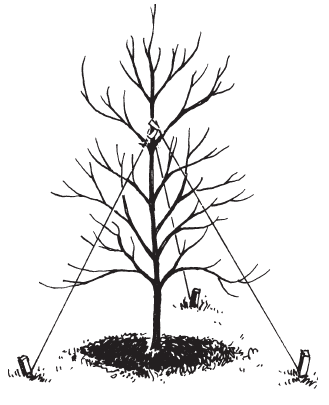
Figure 4. Brace dogwoods larger than 6 to 8 feet high with guys to prevent damage by wind. Stakes may also be used.
Maintaining your dogwood after planting is essential for the survival of the tree. Stake container and bare- root trees if they are planted in a high-traffic or windy area (figure 4). Also water and mulch your dogwood to promote a healthy tree. Check for disease and insects throughout the year. Do not prune or fertilize until the second year. Remove all support stakes and ties after the first year.
General Maintenance Practices
Watering
Watering adequately during the first two growing seasons is important to the survival of the tree. Water newly planted dogwoods once or twice a week during the summer and fall. Watering during the winter is rarely necessary. When you water, thoroughly soak the root- zone area and beyond. After the first growing season, water provided by rainfall should be adequate unless there is a period of drought.
Fertilizing
Little if any fertilizer is needed during the first growing season. Too much nitrogen fertilizer at an early age can result in stunted root growth and injury to the tree. Fertilize established trees twice a year, in February and mid-June, if recommended by a soil test. When applying fertilizer, scatter it evenly within the 100-square-foot area surrounding the tree. Be sure to water after fertilizing.
Mulching
Mulching is important. A 3-to-4–inch mulch layer around the tree conserves soil moisture, modifies soil temperature, reduces competition from weeds and grass, and makes the landscape more attractive. A mulched area also acts as buffer zone between the lawn and the tree trunk, preventing careless mower or trimmer damage to the trunk. Pine straw, pine bark, or leaves are good mulches to use around dogwoods. Add more mulch as needed as the mulch layer diminishes.
Pruning
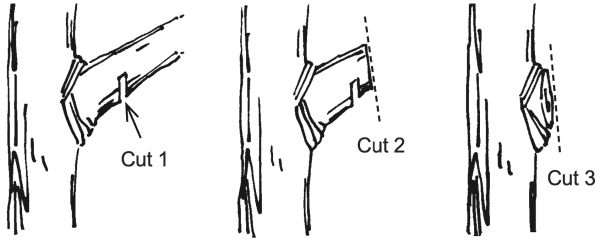
Figure 5. The three-cut pruning method for removing large branches prevents the branch from tearing down the trunk.
Correct pruning makes trees more attractive and healthier. Dogwoods seldom need much pruning. However, it is necessary to remove dead and injured branches, suckers, and diseased or insect-infested parts.
Prune large branches from dogwoods during the dormant season. When pruning a large branch (2 or more inches in diameter), make three cuts (figure 5). Make the first cut under the branch about 6 to 12 inches from the trunk. The cut should go only one-third of the way through the branch. Make the second cut 1 inch beyond the first cut. Cut completely through to remove the branch. Make the third cut at the swollen branch collar to remove the remaining stub. Pruning sealers or wound dressings are of no benefit to the tree.
Insects and Diseases
Dogwoods can be severely damaged or killed by insects and diseases. Routinely check for pests throughout the year. Insects and diseases should be correctly identified and controlled with the proper method. Seek help from your Extension agent or local nursery personnel for proper pest identification and control.
Common insects on dogwoods are the dogwood borer, twig borer, and club gall. Diseases of dogwoods include powdery mildew, anthracnose, crown gall, and trunk canker.
Remember, pesticides can be dangerous if improperly used. Always follow the directions carefully, and consider all precautions indicated on the label.
Summary
The attractiveness of the dogwood explains why it is one of the most popular trees used in the landscape. Selecting a good site and using proper planting and maintenance methods helps the dogwood add beauty to your landscape for many years.
Varieties and Cultivars
More than 100 varieties and cultivars of dogwoods are grown in the United States, twenty to thirty of which are commonly grown in the Southeast. The following list is a selection of some of the most common varieties and cultivars in the trade.
Species/Varieties
Cornus florida
- Height: 20 to 30 feet
- Width: 20 to 30 feet
- Flower color: White
- Growth rate: Moderate
- Spring foliage: Light green
- Summer foliage: Dark green
- Fall foliage: Red to red purple
Cornus florida rubra
- Height: 20 to 25 feet
- Width: 20 to 25 feet
- Flower color: Pink
- Growth rate: Moderate
- Spring foliage: Light green
- Summer foliage: Dark green
- Fall foliage: Red to red purple
Cultivars
Cornus florida ‘Cherokee Chief’
- Trade name: Cherokee Chief
- Height: 15 feet
- Width: 15 feet
- Flower color: Red
- Growth rate: Moderate
- Spring foliage: Yellow green
- Summer foliage: Green
- Fall foliage: Bronze
- Remarks: Blooms rich ruby red; new growth reddish. Moderately resistant to powdery mildew.
Cornus florida ‘Cherokee Princess’
- Trade name: Cherokee Princess
- Height: 15 feet
- Width: 15 feet
- Flower color: White
- Growth rate: Slow
- Spring foliage: Yellow green
- Summer foliage: Green
- Fall foliage: Red
- Remarks: Heavy white blooms, larger than average. Variable resistance to powdery mildew.
Cornus florida ‘Cloud 9’
- Trade name: Cloud 9 or Barton’s White
- Height: 15 feet
- Width: 15 feet
- Flower color: White
- Growth rate: Slow
- Spring foliage: Yellow green
- Summer foliage: Green
- Fall foliage: Red purple
- Remarks: These two cultivars were found to be the same based on DNA tests, although powdery mildew appears less severe in Barton’s White in recent trials. Produce prolific white flowers at an early age.
Cornus florida ‘Cherokee Daybreak’
- Trade name: Cherokee Daybreak
- Height: 25 feet
- Width: 20 feet
- Flower color: White
- Growth rate: Moderate
- Spring foliage: Light green
- Summer foliage: Variegated
- Fall foliage: Pink to deep red
- Remarks: A variegated cultivar with bright green and creamy white summer foliage and white blooms in spring. Moderately resistant to powdery mildew.
Cornus florida ‘Cherokee Sunset’
- Trade name: Cherokee Sunset
- Height: 25 feet
- Width: 20 feet
- Flowers: Purplish red
- Growth rate: Moderate
- Spring foliage: Red purple
- Summer foliage: Variegated
- Fall foliage: Red purple
- Remarks: An improved red-flowering, variegated-leafed variety with distinctive green and yellow summer foliage leaf margins. Reportedly resistant to anthracnose.
Other Selected Cultivars
Cornus florida ‘Junior Miss’
A large flowering form with the outer portions of the bract pink, grading to whitish in the center. Susceptible to powdery mildew.
Chinese dogwood (Cornus kousa)
Chinese dogwood or one of the more recent Rutger hybrids can be used to extend the dogwood blooming season. In full-sun locations, Chinese dogwood is recommended instead of the native dogwood, Cornus florida.
 Revised by Kerry Smith, Outreach Programs Administrator, Horticulture, Auburn University. Originally prepared by J. David Williams, former Extension Specialist; Ken Tilt, former Extension Horticulturist; and Carlton Davidson, former student, all in Horticulture with Auburn University.
Revised by Kerry Smith, Outreach Programs Administrator, Horticulture, Auburn University. Originally prepared by J. David Williams, former Extension Specialist; Ken Tilt, former Extension Horticulturist; and Carlton Davidson, former student, all in Horticulture with Auburn University.
Revised May 2023, Selection and Care of Dogwoods, ANR-1077

